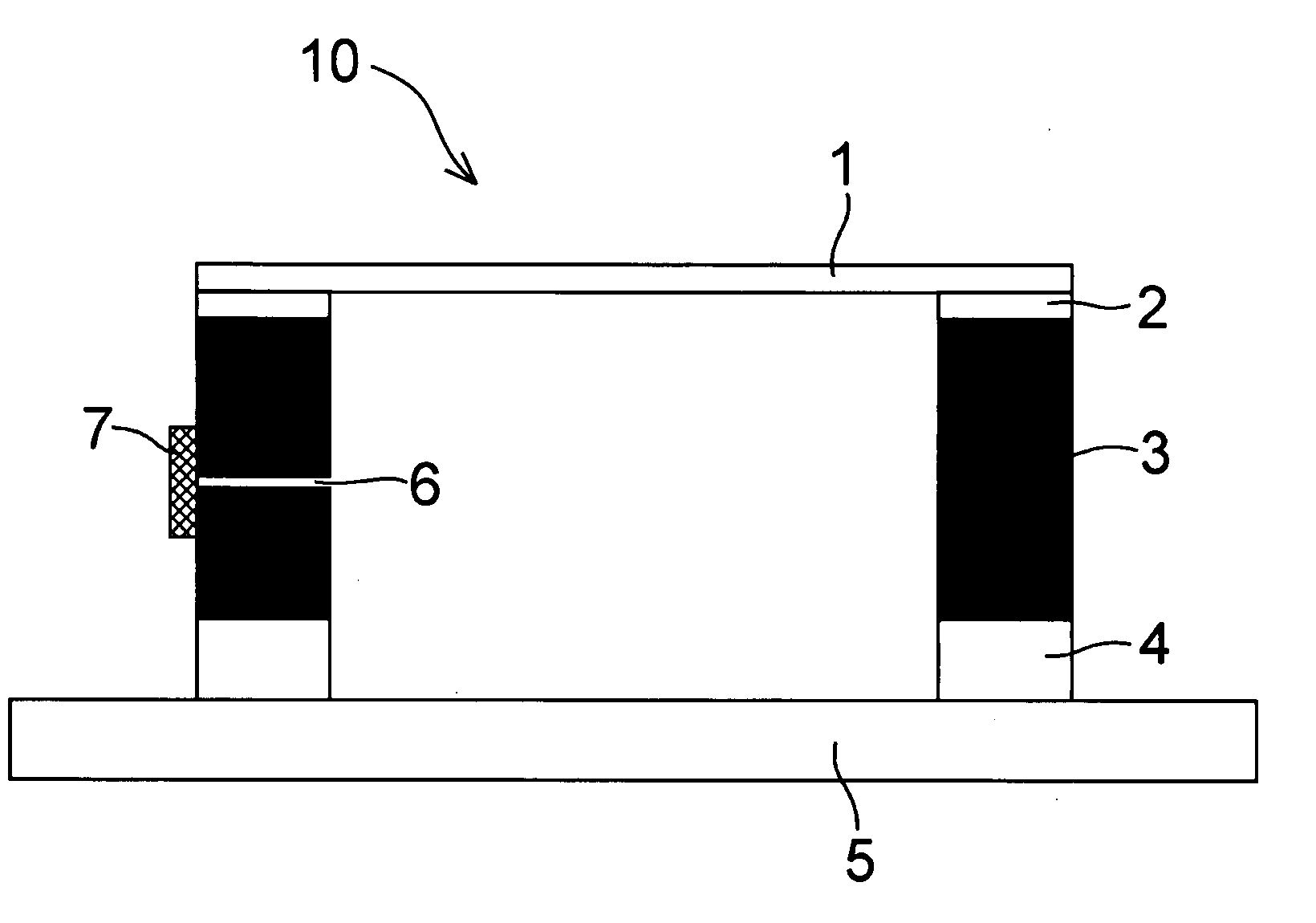Pellicle
a lithography and pellicle technology, applied in the field of lithography, can solve the problems of difficult to always keep the exposure master plate clean, affect the yield of semiconductors, and affect the quality of the exposure, so as to reduce the amount of water-soluble ions and reduce the amount of outgassing
- Summary
- Abstract
- Description
- Claims
- Application Information
AI Technical Summary
Benefits of technology
Problems solved by technology
Method used
Image
Examples
example 1
[0057]First, as a pellicle frame, a frame was prepared using an A7075-T651 aluminum alloy so that the frame outer dimensions were 149 mm×122 mm×5.8 mm and the frame thickness was 2 mm. A vent having a diameter of 0.5 mm was provided in the middle on one side face of the frame.
[0058]After the surface of the frame was washed, the surface was roughened by subjecting it to a surface treatment for 1 minute employing a sandblasting machine using glass beads with a discharge pressure of 1.5 kg / cm2. Subsequently, the surface was etched by immersing it in an alkaline solution and then washed with water. After rinsing with pure water, it was subjected to electrodeposition coating with an Elecoat Frosty W-2 solution adjusted to 25° C. (Shimizu Co., Ltd; thermosetting anionic type, matte type; black paint) so that the coating thickness would be 5 μm (since the coating thickness depended on the condition of the solution, a dummy frame was fed in advance, and the voltage and time for the electrod...
example 2
[0068]In the same manner as in Example 1, as a pellicle frame, a frame was prepared using an A7075-T651 aluminum alloy so that the frame outer dimensions were 149 mm×122 mm×5.8 mm and the frame thickness was 2 mm. A vent having a diameter of 0.5 mm was provided in the middle on one side face of the frame.
[0069]After the surface of the pellicle frame was washed, the surface was roughened by subjecting it to a surface treatment for 1 minute employing a sandblasting machine using glass beads with a discharge pressure of 1.5 kg / cm2. Subsequently, the surface was etched by immersing it in an alkaline solution and then washed with water. After rinsing with pure water, it was subjected to electrodeposition coating with an Elecoat Frosty W-2 solution adjusted to. 25° C. (Shimizu Co., Ltd) so that the coating thickness would be 18 μm (since the coating depended on the condition of the solution, a dummy frame was fed in advance, and the voltage and time for the electrodeposition step were det...
example 3
[0078]In the same manner as in Example 1, as a pellicle frame, a frame was prepared using an A7075-T651 aluminum alloy so that the frame outer dimensions were 149 mm×122 mm×5.8 mm and the frame thickness was 2 mm. A vent having a diameter of 0.5 mm was provided in the middle on one side face of the frame.
[0079]After the surface of the frame was washed, the surface was roughened by subjecting it to a surface treatment for 1 minute employing a sandblasting machine using glass beads with a discharge pressure of 1.5 kg / cm2. Subsequently, the surface was etched by immersing it in an alkaline solution and then washed with water. After rinsing with pure water, it was subjected to electrodeposition coating with an Elecoat Frosty W-2 solution adjusted to 25° C. (Shimizu Co., Ltd) so that the coating thickness would be 3 μm. After shower-rinsing with pure water, a heat treatment was carried out in an oven at 200° C. for 30 minutes.
[0080]When analysis was carried out in the same manner as in E...
PUM
| Property | Measurement | Unit |
|---|---|---|
| emissivity | aaaaa | aaaaa |
| thickness | aaaaa | aaaaa |
| thickness | aaaaa | aaaaa |
Abstract
Description
Claims
Application Information
 Login to View More
Login to View More - R&D
- Intellectual Property
- Life Sciences
- Materials
- Tech Scout
- Unparalleled Data Quality
- Higher Quality Content
- 60% Fewer Hallucinations
Browse by: Latest US Patents, China's latest patents, Technical Efficacy Thesaurus, Application Domain, Technology Topic, Popular Technical Reports.
© 2025 PatSnap. All rights reserved.Legal|Privacy policy|Modern Slavery Act Transparency Statement|Sitemap|About US| Contact US: help@patsnap.com


